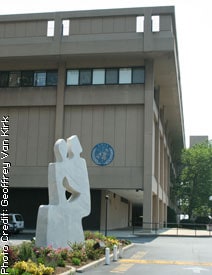BUENA PARK, Calif. — A decade ago when
George Nicholson moved from Beirut to teach music at the United Nations International School (UNIS) in Manhattan, the music department had two Yamaha P22 studio pianos, a Yamaha C3 conservatory grand piano and a complement of Yamaha band instruments. Over the years, two more P22s were added, and this spring, UNIS purchased five new P22 studio pianos and replaced the C3 with a brand new Yamaha C7 conservatory piano.
 The UN International School |
"The music department had wanted a new grand piano for the Sylvia Howard Fuhrman Centre for the Performing Arts for a number of years," Nicholson says, "and the Yamaha C7 is just the right size instrument for our one and only theater. The 350-seat hall is used for assemblies, school concerts, student recitals, performances by musical guests, choir classes and play production. The bass in the C7 is rich and resonant, and it offers a warm, lush sound. It really fills the hall." The nine Yamaha P22s are placed in music classrooms and private lesson studios. "We were advised that Yamaha pianos would stand up really well for heavy school use over the long haul."
UNIS was founded in 1947 by UN affiliated families; today, its multinational staff hail from 70 countries and nearly 1,500 K-12 students are enrolled from 115 countries. "About 400 students take private music lessons and about 65 of those study piano. The pianos are used for private lessons, and for our jazz bands, chamber music ensembles, and choral accompaniment," says Nicholson, the head of the music department and one of seven full time music teachers. A popular series, "Fridays at Four," offers piano students an informal opportunity to perform every other week for parents and students.
 The UN International School as seen from across the
East River in New York City. |
The sequential music program is based on the Kodály system and encourages music literacy for everyone. All K-4 students participate in singing based musical activities and in 5th grade each child chooses an orchestral instrument to study. After the 5th grade, students may return to a singing based curriculum or continue with their chosen instrument until 8th grade. In high school, a one-year requirement of music instruction may be met through chorus, music appreciation or instrumental studies; 80 percent of students further their musical studies as an elective. "The parents value music in their own lives and in the lives of their children," says Nicholson.
The school's music programming, staffing and philosophy reflect the diversity of the student body, says Nicholson, who also taught in Costa Rica and Canada. "We have amazing discussions in our classrooms. Students from other international schools come here to perform: this year, they were from Spain and Australia, and next year, Japanese students will perform. Recently, local Iranian musicians offered a student concert; professional musicians often perform as a governmental goodwill gesture or because they've heard about the school. In our setting, providing music for concert band or string ensemble may mean teachers take a piece of music and ‘dress it up' with other instrumentation."
For more information, please visit
www.unis.org.


